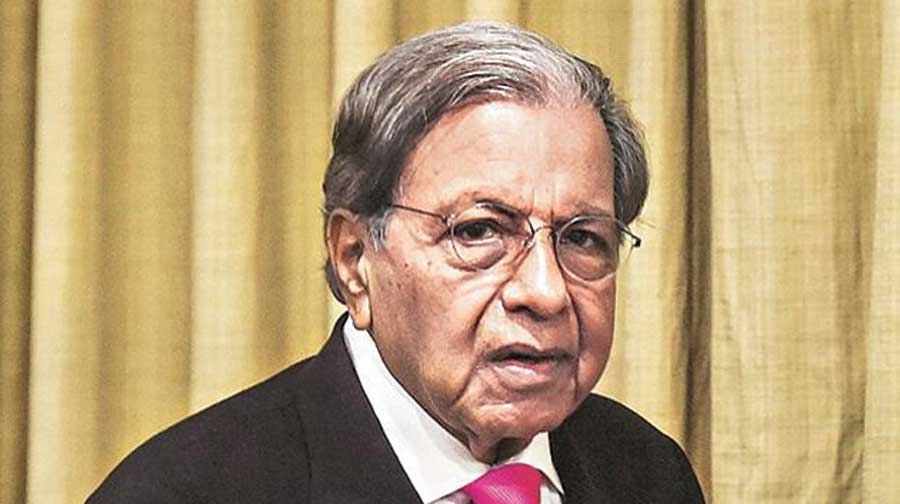India will see a sharp V-shaped recovery in the third and fourth quarter of the current fiscal, but GDP in 2020-21 would ultimately contract as the coronavirus lockdown has led to serious demand and supply dislocations, N.K. Singh, chairman of the 15th Finance Commission, said on Monday.
Stating that the global economic depression will continue to cast a shadow on growth prospects next fiscal, Singh said the economic expansion in 2022-23 would determine whether or not the initiatives to revive growth are sustainable.
“This pandemic has led to enormous economic consequences by way of lockdown which brought serious dislocation both on the demand and supply sides,” Singh said at an AIMA event here.
“The first and second quarters will not be lofty performances to say the least... I think in the third and fourth quarter of the current fiscal year, there would be a very sharp V-shaped recovery... not necessarily that anything fundamental will happen or may happen but because of a lower base. Nonetheless, fiscal year as a whole would end on a negative trajectory,” he said.
India’s economic growth stood at an estimated 4.2 per cent in 2019-20. The growth projections for the current year by various global and domestic agencies indicate a sharp contraction of the economy ranging from (-)3.2 per cent to (-)9.5 per cent.
Singh feels for a country of India’s size, the ideal debt to GDP ratio should be 60 per cent and to reach that level in the medium term would require fiscal deficit to be aligned to this debt objective.
India’s debt to GDP ratio stood at 70 per cent of GDP in 2019-20 and is projected to touch 80 per cent in the current fiscal.
Bank capital
The recapitalisation needs of state-owned banks for a five year period are being figured out with the government, Singh said.
“The banking secretary has made a separate presentation to the Finance Commission and,” Singh added.
“I think over the next five years, there will be a huge public outlay which will be needed to keep PSU banks adequately recapitalised,” he added.
“Bank recapitalisation is not a panacea for the more serious ills which afflict our banking system and much deeper reforms are needed. Post-1991, one sector that has remained comparatively closed has been the banking and insurance sector,” said Singh.
Banking reforms are the “centrepiece of economic revival and the catalyst for economic change”, he added.
The plans of state-owned banks to raise capital from private sources will not be sufficient to mitigate anticipated risks unless supplemented with more capital support from the government, Fitch Ratings said. Several large state banks have recently announced plans to raise a total of $6 billion in fresh equity from the capital market.
Fitch said state banks already face significant execution risks in raising equity due to depressed stock market valuations and weak investor interest. "Indian state-owned banks' plans to raise capital from private sources will not be sufficient to mitigate anticipated risks unless supplemented with additional capital support from the state," Fitch Ratings said.
It said a reduction in the state's majority shareholding in some of its banks may dent depositor confidence and potentially lead to negative rating action as their long-term ratings are anchored to state support.
Singh said liberalising the banking and insurance sectors should be a high priority for the government. “Banking and insurance continues to be definitely an overprotected sector in the economy,” he said.
Without outright privatisation, the government should think of ways to improve the quality and predictability of financial intermediation, he said.
While the commission was tasked with recommending a fiscal consolidation road map to the government for the next five years, Singh said this was not a year to be concerned with consolidation.
“This is not a year in which we should look at any kind of path of fiscal (consolidation). This is a year to concentrate on whatever it takes to deal with this pandemic,” he said.
The challenge facing the government is to balance three objectives of managing the pandemic, managing the economic revival process and buttressing defence capability while being “straitjacketed” by not wanting to abandon the norms of overall macroeconomic stability, said Singh.
Growth
He said the country will see a sharp V-shaped recovery in the third and fourth quarter of this financial year, but GDP growth for the fiscal will be in negative territory as the lockdown forced by Covid-19 led to serious demand and supply dislocations.
“This pandemic has led to enormous economic consequences by way of lockdown which brought serious dislocation both on demand and supply sides,” he said.
“Q1 and Q2 will not be lofty performances to say the least. I think in Q3 and Q4 of the current fiscal year, there would be a very sharp V-shaped recovery, not necessarily that anything fundamental will happen or may happen but because of a lower base. Nonetheless, fiscal year as a whole would end on a negative trajectory,” said Singh.
Most agencies have projected contraction for India, with ICRA revising it downwards to minus 9.5% from 5% forecast earlier.
Singh said the global economic depression will continue to cast a shadow on growth prospects next fiscal. He said the economic expansion in 2022-23 would determine whether or not the initiatives to revive growth are sustainable.

